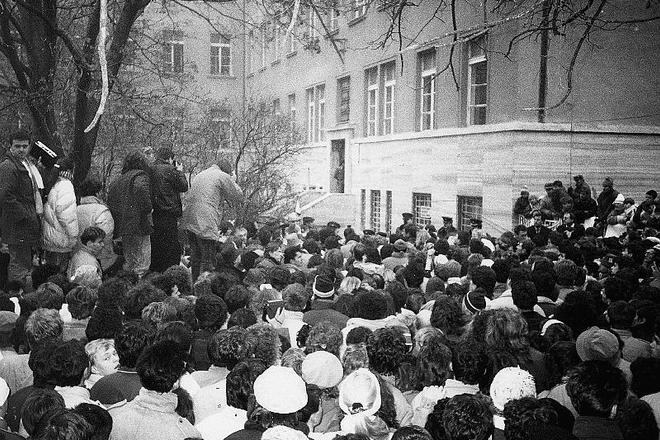On November 17, Slovakia will commemorate the 20th anniversary of the Velvet Revolution in which the former communist Czechoslovakia and generally all of eastern and central Europe freed itself from domination by the Soviet Union. Three years after the revolution Czechoslovakia peacefully separated into two countries, the Czech Republic and Slovakia. In addition to dissidents who had worked against the totalitarian regime for many years, students in 1989 were a key part of the Velvet Revolution. Sociologists and student leaders note that students has neither much property nor good positions to be lost and believed in the values and ideals of a different system and that is why they were the first to flood the streets of the country and show resistance to the communist regime. Students dared to take on the authorities in the streets – especially in Prague where the events were most violent – without knowing whether the ruling regime would or would not send troops and police to suppress the demonstrations.
Filip Vagač, one of the leaders of the November 1989 actions in Slovakia who currently works for the Ján Langoš Foundation and the charity Hodina deťom, recalls that in September he decided – together with many other students – to give back his “Socialist Union of Youth” membership card and to prepare a petition for the student bulletin board demanding more freedom and less control by the Communist Party organisation. They collected more than thousand signatures, which seem to prove that “something was in the air even before November”.
On November 17, the anniversary of the closure of universities by Nazis before World War II which subsequently became International Students Day, a big march was organised in Prague. Spontaneously, it turned into a demonstration against the regime. One thing that might have decided the course of the revolution in Czechoslovakia was an attempt by the ŠtB secret police to threaten people with persecution and to make them step back in fear so the ŠtB spread the word that a student, Martin Šmíd, was killed during the Prague demonstration.
There was no internet or mobile phones; only the state-controlled media. When the Voice of America radio station, and later also Austrian and German media, broadcast information about his death, everyone believed it. However, the impact was quite different than what the ŠtB expected: students, dissidents, and ordinary people in Prague and Bratislava flared up and organised a continuation of the demonstration before the authorities managed to officially deny this information.
“They wanted to threaten us, but this was the moment when we thought – what right do we have to live, if he was killed,” said Vagač. And students stopped going to classes and lectures and rather copied documents, billboards and other materials rousing citizens to break their silence and voice their opinions. They literally invaded and occupied the Academy of Performing Arts and typed the documents with carbon paper as the copier of the college was locked and they had no key. People started to bring them food and paper, and sometime later, they filled streets and squares. Some Slovaks were angry about not being allowed to travel freely, some were furious about their stupid bosses who got their positions because of Communist Party membership, and in this way, the revolution slowly started rolling through other parts of Slovakia. In Prague and the Czech Republic generally, the dissident movement was stronger as well as the suppressive acts of the regime and for that reason the events of looked different.
In Slovakia, the two groups that came to represent the faces of the revolution were students and dissidents and other “adult” activists who later formed the political party Public against Violence (Verejnosť proti násiliu). Although relations between the students and the adults were tense from the beginning, they never publicly stood against one another.
“We solved the small practical issues, when they focused on the “big politics”, said Vagač. None of the then-students stayed in politics. Most of them returned to their original study programmes and sought various professions after the revolution while others became engaged in civic associations and NGOs. One former student, Juraj Vaculík, who owns a very successful advertising agency, led the presidential campaign for Martin Bútora, also a former dissident. Vaculík also developed the campaigns that called on Slovak citizens to go to the polls in the crucial year 1998 when the rule of Vladimír Mečiar and his coalition partners was ended.
When the revolution was already in full swing František Šulka from the Slovak Railways offered to help. Two trains were sent: one to the eastern Slovak city of Košice and one to Romania. The one meant for Košice was supposed to awaken and shake the citizens there to life – but by that time they had already been engaging in a general strike for some time and the arrival of the train just made them angry. The train to Romania was loaded with tins and durable food. Students managed to collect one million crowns – a huge sum for that time – and also food and blankets. The head of the state chain of department stores, Prior, opened the store for them and they bought food and sent it to Romania where the revolution was advancing in a much more violent way.
One of the student leaders, Miloš Durec, accompanied the train and he remembers the journey even now. It was Christmas Day and in Romania passion and desire for revenge won over. There were shoot-outs in the streets and violence could be felt everywhere. Slovaks met Romanian revolutionaries, handed over the humanitarian help and returned with the government airplane which had to wait for several hours due to bad weather, until it could get off and fly them to safety.



 Protesters in Bratislava in 1989 demand freedom for political prisoners. (source: Archive of J. Čarnogurský)
Protesters in Bratislava in 1989 demand freedom for political prisoners. (source: Archive of J. Čarnogurský)